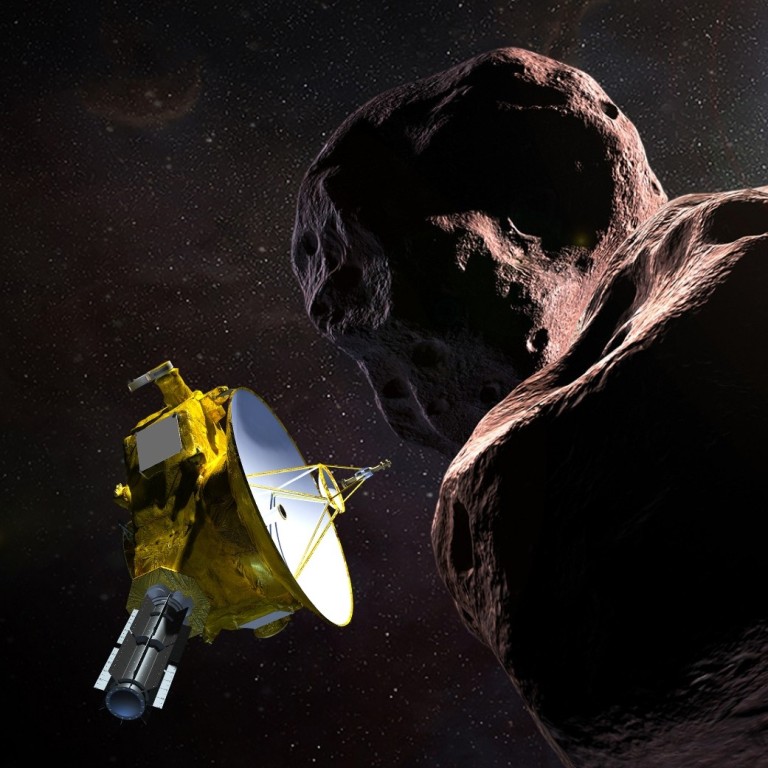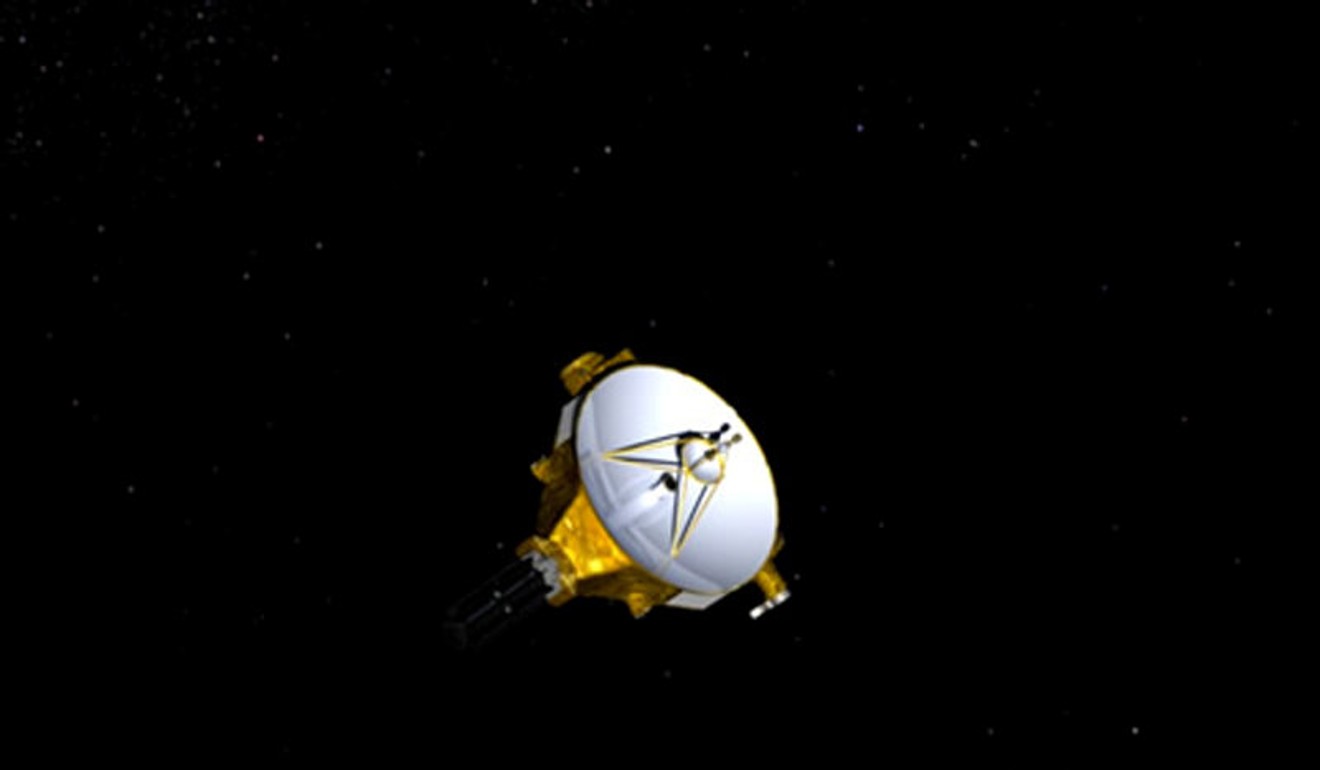
Event Horizon: Nasa spacecraft makes history, flies past Ultima Thule 6.4 billion km from Earth
- Nasa spacecraft New Horizons in historic fly-by of the farthest, and quite possibly the oldest, cosmic body ever explored by humankind
- Ultima Thule is a cool mass roughly 32km long and shaped like a giant peanut
The nerdiest new year’s party in the solar system happened Tuesday 6.4 billion km from Earth, where Nasa spacecraft flew past a distant world called Ultima Thule, the furthest object humans have ever explored.
Nasa rang in the new year with a live online broadcast to mark the spacecraft’s zoom past the mysterious object located in a dark and frigid region of space known as the Kuiper Belt.
“Go New Horizons!” said lead scientist Alan Stern as a crowd cheered at the Johns Hopkins Applied Physics Laboratory in Maryland to mark the moment at 12:33am (1.33pm Hong Kong time) when the New Horizons spacecraft aimed its cameras at the space rock four.
“Never before has a spacecraft explored something so far away.”
About 10 hours later, a series of anxiously awaited “phone home” signals arrived, indicating that the spacecraft had indeed made it, intact, through the risky, high-speed encounter.
“We have a healthy spacecraft,” said mission operations manager Alice Bowman, as cheers erupted again in the lab.
The spaceship was to collect 900 images over the course of a few seconds as it shaved by at a distance of about 3,500km at a speed of 51,500km/h (32,000mph).
Real-time video of the actual fly-by was impossible, since it takes more than six hours for a signal sent from Earth to reach the spaceship, named New Horizons, and another six hours for the response to arrive.
A solo track recorded by legendary Queen guitarist Brian May – who also holds an advanced degree in astrophysics – was being released to accompany a video simulation as Nasa commentators described the close pass.
China’s Chang’e 4 spacecraft to try historic landing on far side of moon ‘between January 1 and 3
Stern said that Ultima Thule was unique because it was a relic from the early days of the solar system and could provide answers about the origins of other planets.

“The object is in such a deep freeze that it is perfectly preserved from its original formation,” he said.
“Everything we are going to learn about Ultima – from its composition to its geology to how it was originally assembled, whether it has satellites and an atmosphere and those kinds of things – are going to teach us about the original formation conditions of objects in the solar system.”
But the encounter itself was risky, and if the spacecraft were to collide with a speck of space debris as small as a grain of rice, it could be destroyed instantly, mission managers warned.
For that reason, Stern said he and his colleagues were “on pins and needles to see how this turns out”.
The first signal back to Earth should come about 10 hours after the fly-by, around 9:45am (10:45pm Hong Kong time). Only then will Nasa know if New Horizons survived the close pass.

Scientists are not sure what Ultima Thule (pronounced TOO-lee) looks like – whether it is cratered or smooth, or even if it is a single object or a cluster.
It was discovered in 2014 with the help of the Hubble Space Telescope, and is believed to be up to 32km in size.
A blurred and pixelated image released Monday, taken from 1.9 million km away, has intrigued scientists because it appears to show an elongated blob, not a round space rock.
Even clearer images should be in hand over the next few days.
Scientists decided to study it with New Horizons after the spaceship, which launched in 2006, completed its main mission of flying by Pluto in 2015, returning the most detailed images ever taken of the dwarf planet.

Seven instruments on board will record high-resolution images and gather data about its size and composition.
Every 20 minutes, the spacecraft’s cameras and infrared imagers are capturing shots of the space rock, “so as it rotates and we get closer we will get good data on all parts of it as we approach,” said John Spencer, a scientist with the Southwest Research Institute.
Breakthrough as Virgin Galactic launches humans into space, a US first since the end of shuttle programme
Stern said the goal was to take images of Ultima that are three times the resolution the team had for Pluto.
Ultima Thule was named for a mythical, far-northern island in medieval literature and cartography, according to Nasa.

Project scientist Hal Weaver of the Johns Hopkins Applied Physics Laboratory said humans did not even know the Kuiper Belt – a vast ring of relics from the formation days of the solar system – existed until the 1990s.
“This is the frontier of planetary science,” said Weaver.
Nasa’s InSight spacecraft takes first ‘selfie’ after flawless landing on Mars
“We finally have reached the outskirts of the solar system, these things that have been there since the beginning and have hardly changed -we think. We will find out.”
In an editorial in The New York Times, Stern recalled that December 2018 marks the 50th anniversary of the first time humans ever explored another world, when US astronauts orbited the Moon aboard Apollo 8.
“New Horizons will continue in that legacy,” Stern wrote.
“As you celebrate New Year’s Day, cast an eye upward and think for a moment about the amazing things our country and our species can do when we set our minds to it.”
While the mission marked the farthest close-encounter of an object within our solar system, Nasa’s Voyager 1 and 2, a pair of deep space probes launched in 1977, have reached greater distances on a mission to survey extrasolar bodies.
Both probes are still operational.
The Washington Post, Agence France-Presse, Reuters
